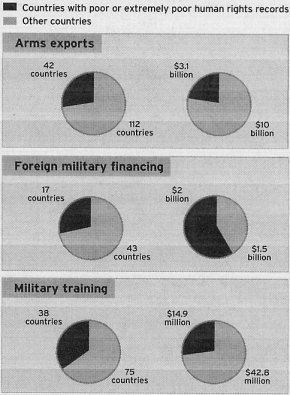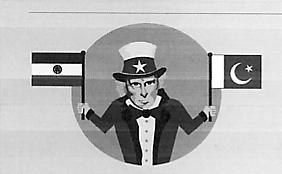GUNS R U.S.
THE UNITED STATES CONTINUES TO BE THE WORD'S LARGEST WEAPONS SUPPLIER,
CAPTURING A 45.8 PERCENT SHARE OF THE $12.1 BILLION GLOBAL ARMS MARKET IN 2001.
SINCE SEPTEMBER 11, THE BUSH administration has relied heavily on a quiet campaign of defense deals as a way to win friends for its war on terror. The unsurprising result: a significant increase In U.S. arms transfers and military aid. Although the purported goal Is to improve U.S. security, too often military aid has gone to repressive regimes
that use the assistance to violate the human rights of their own populations. Sometimes, these weapons and technologies fall into hostile hands and they end up being used against the United States.
The gears that drive the deals that ratchet up military aid for U.S. allies have been greased in the post-September 11 world by the steady erosion of restrictions on military transfers. Some of the more significant changes and proposals so far include:
- Congress broadened the U.S. role in Colombia from
counternarcotics support to a "unified campaign"
against insurgents and narco-traffickers. - The Bush administration wants to lift a ban on
training Indonesia's military (placed because of its failure to comply with human rights-related rules).
- Congress wants to give $403 million in military
aid and assistance to Central Asian war-on-terror allies—despite these regimes' failure to democratize or to respect
human rights.
- The United States gave the republic of Georgia
$64 million to train and equip its military to hunt Al Qaeda members living among Chechen rebels on its Russian
border.
- The Philippines received about $100 million in U.S. security assistance, including transport planes, utility helicopters, a naval patrol boat, and 30,000 M-16 rifles. The U.S. military also deployed 1,200 soldiers to train and help Philippine troops pursue the Abu Sayyaf group, an organization allegedly linked to Al Qaeda.
Nepal, for starters:
There have been some Interesting surprises In the "war, " including its major beneficiaries. The table shows U.S. war on terror-related aid to certain lucky countries before and after September 11,2001. The "before" totals include aid appropriated under the 2001 Foreign Operations Appropriations Act; “after” totals include aid in two supplemental appropriations acts passed after September 11, 2001 and aid requested as part of the 2003 Foreign Operations Appropriations Act.
| Before | After | |
| Djtbouti Indonesia Kyrgyzstan Nepal Pakistan Philippines Tajikistan Turkmenistan Uzbekistan Yemen |
$0.6 $49.9 $35.3 $0.2 $3.5 $7.4 $16.7 $7.3 $28.1 $5.3 |
$6.4 $76.9 $87.8 $29.5 $1,293.5 $82.9 $70.4 $19.2 $171.7 $38.6 |
|
( in millions ) |
 What goes around...
What goes around...During the 1980's, the Reagan administration secretly gave hundreds of man-portable surface-to-air Stinger missles to the mujahideen in Afghanistan and to UNITA rebels in Angola. These 1.5-meter “fire-and -forget” missiles shot down dozens of Soviet attack helicopters. But the qualities that made the Stinger an effective weapon against the Soviets ( portability, lethality, and ease of use ) also make them a grave threat to U.S. Military and commercial aircraft—and an ideal black market commodity. Hundreds of Stingers originally transferred to the mujahideen quickly vanished into the illegal global arms pipeline and ended up in the hands of terrorists,
China, Iran, Qatar, Pakistan, the former Soviet Union, and even North Korea are all believed to have ill-gotten Stingers. And many non-state actors suspected of illicitly acquiring Stinger missliles are now recognized as terrorist organizations by the State Department. These include the Armed Islamic Group (in Algeria), Islamic jihad/Hezbollah, the Kurdistan Workers Party (in Turkey), the Tamil Tigers (Sri Lanka), and last—but definitely not least—Al Qaeda.
The United States approved arms exports and
military aid to 170 countries in 2001, delivering $13.1
billion in commercial and government-to-government
arms sales to 154 of those countries.
In 2001, 60 countries were the lucky recipients of
$3.5 billion in U.S. foreign military financing, allow-
ing the United States to dole out money for purchas-
ing U.S. weapons, military service, and training. All
but 5.4 percent of 2001 financing went to Israel,
Egypt, and Jordan, as a reward for making peace
with one another.
In 2001, the United States gave 113 nations $57.7
million for "international military education and
training" (IMET)—aid to foreign governments to
teach their military personnel ( think of it as "Military
101" ). The U.S. military offers more than 2,000
courses, including classes in combat skills, military
management, civilian-military relations, and the use
of U.S. weapons systems.
The United States Isn't too choosy about who gets
these goodies. Many of the 2001 recipients weren't
exactly good guys. A number of them, in fact, were
characterized by the State Department as having
"poor" or "extremely poor" human rights records.
Who gets U.S. military weapons and aid?
Not just the good guys.


| To India: 12 Firefinder artillery- locating radars; parts for Sea King helicopters, HAWK trainer aircraft, and air defense radars. Total security assistance to India since 9/11: $17 million |
To Pakistan: Six used C-130E cargo aircraft with engines; six Aerostat L-88 radar sys- tems; 400 grenade launch- ers and other riot control gear; parts for C-130s, UH- 1H helicopters. M113 armored personnel carri- ers, and F-16 fighter jets. Total security assistance to Pakistan since 9/11: 613 billion |
In anticipation of Pakistan's crucial role in the war
on terror, the U.S. government lifted sanctions on
Pakistan and India that had been in place since the
two saber-rattlers decided to test their nukes in
1998. In 2002, political tensions on the subcontinent
threatened to erupt into conflict that many feared
would "go nuclear." Despite this, the United States
moved forward with its arms deals. At the same time
It was publicly pressuring Pakistan and India to re-
strain themselves, the U.S. government was quietly
approving weapons transfers to both. The transfers
at left have already been approved.
By Tamar Gabelnick and Matt Schroeder ofthe Feder-
ation of American Scientists Arms Sales Monitoring
ProJect. More information on U.S. and global armssales Is available online at www.fas.org/asmp.
Source:
Federation of American Scientists
Arms Sales Monitoring Project
Go to original HTML | PDF
